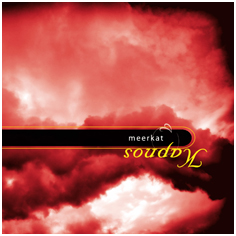[reviews]
afe121cd
meerkat: kapnos
webzine, usa, July 2009
It's been almost a full century since the Italian Futurist (and painter/composer) Luigi Russolo wrote his manifesto, The Art of Noises, and yet his notion of creating music from non-pitched sound still inspires controversy. Russolo seems prescient in predicting much of the future of electronic music, particularly the freedom created by tape and later digital manipulation. Despite the trend in the avant-garde, however, the palate of the masses still finds it difficult to appreciate the art of noise.
Edgar Varèse famously stated that any "organized sound" constitutes dismantling the distinction between noise and music. Partially inspired by these earlier formulations, during the post-war years, the French radio-engineer Pierre Schaeffer conducted the earliest tape manipulations and coined the term musique concrète to describe his results, a composition made entirely out of non-musical recordings. Later producers, particularly in jazz and electronic music, took these notions seriously, and these Italians represent some of the most sophisticated practitioners of the concept today. The antics of Meerkat still have the power to startle.
The third disc in the "Between the Element" quadrilogy envisioned by Italian sound artists Matteo Uggeri (Hue, Sparkle in Grey), and Maurizio Bianchi (MB), "Kapnos" brings together ten of the leading Italian artists working in electronic sound design today. Hue may already be a familiar name, having contributed to the past two volumes in the series, as well as Luca Bergero (Fhievel), who contributed to the first volume. The other artists bring a variety of skills to the mixing-table, coming from various projects with different focuses. An Italian super-group (in the most niche way imaginable) making bizarre musique concrète (or should it be musica concreta?) may not sound like much, but to enthusiasts, "Kapnos" is a treat. These artists mold noise into a form of raw beauty. It's not musical, at least not in the conventional sense, but is an art of noise, an ambient music in the most literal sense.
On "Kapnos", certain elements or motifs are repeated throughout, granting a cohesion despite the fact that virtually no track on the album shares members with any other. Sometimes, expected samples are identified; crackling fire, a flame raging, but mostly it is in the process of creation that the spirit of "Kapnos" is realized. One artist may create a landscape of guitar and electronics, the material so to speak, while the collaborator will treat them, modulating and affecting, weaving in field recordings, until it is set ablaze, the result being the smoke, difficult to grasp and quickly vanishing.
The tracks of "Kapnos" present a surprising homogeneity in spite of the different attitudes of the artists, creating new unforeseen connections, working in pairs or in threesome per each track. They are without title, simply numbered "One" through "Seven", which limits our ability to provide interpretation. I suspect this was done to increase the ephemeral quality, refusing to allow meaning to be grasped.
One's instinct is to try to identify the source of the sound they perceive. Schaeffer addressed this very urge in his essay "Acousmatics," arguing that sound has become disembodied in the age of recorded music. One needn't separate the subjective and objective, our perception and the source, but instead we should just relate to the sound as it is being experienced. Meerkat sometimes use pitched sound and often use white noise or unpitched sound. Rather than organize their compositions traditionally, by meter, rhythm, melody and so on, they use ambient techniques, creating layers, controlling durations and resonance, and mapping out a less familiar architecture. It is futile to sit and listen, trying to imagine how these sounds were created, but rather inhale the frequencies and discover a new atmosphere without preconceptions of their creation.
"Between the Elements" implies a hybridization. A cloud is a mix of air and water, a desert a mix of earth and fire, and smoke of fire and air. Whereas "Nefelodhis" swirled and "Erimos" took pleasure in its bareness, "Kapnos" simply resists. Neither of the prior releases in the series embodied their concept in a predictable realization, and neither does this latest installment. Clichés and literal-minded mimesis would be too easily dismissed, so rather the compositions themselves seem as insubstantial and temporary as smoke, falling in between the solid closedness of earth and the destructive openness of fire. Its sister album "Pagetos" (or morning frost) will be out next year, completing the project. "Kapnos" is ethereal, opaque yet also purifying and I look forward to experiencing the mirror version next year.
[Joseph Sannicadro]
